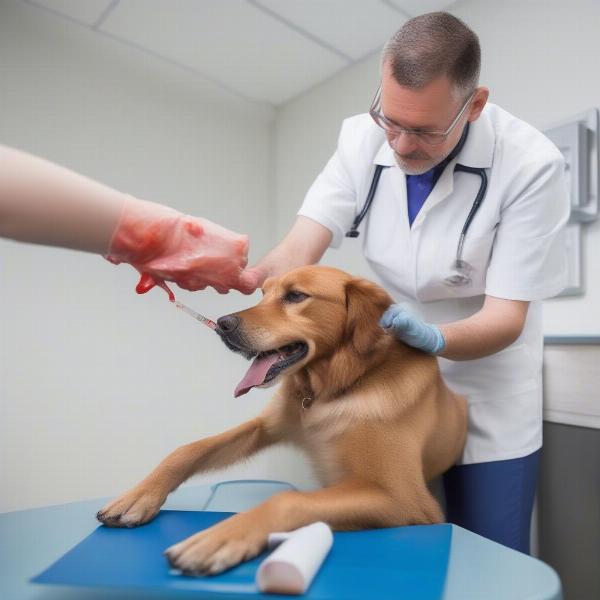Understanding your dog’s blood glucose levels is crucial for their overall health. Knowing what is normal blood glucose for a dog can help you identify potential problems early on and ensure your furry friend receives the proper care. This article will provide you with all the information you need to understand normal canine blood sugar levels, factors that can influence them, and when to seek veterinary advice.
Understanding Canine Blood Sugar
Just like in humans, dogs need glucose for energy. This sugar is derived from the food they eat and is regulated by insulin, a hormone produced by the pancreas. A healthy balance of glucose and insulin is essential for maintaining your dog’s overall well-being. However, various factors can disrupt this balance, leading to either high or low blood sugar, both of which can have serious consequences.
Normal Blood Glucose Range for Dogs
So, what is normal blood glucose for a dog? The generally accepted normal range for canine blood glucose is between 70 and 120 mg/dL (milligrams per deciliter). This means that a healthy dog’s blood sugar will typically fall within these parameters when measured after fasting for several hours. However, it’s important to note that slight fluctuations can occur throughout the day, depending on factors like diet, activity levels, and stress. normal bg for dogs provides a deeper look into this topic.
Factors Influencing Blood Glucose
Several factors can influence a dog’s blood glucose levels. Diet plays a significant role, with high-carbohydrate meals potentially leading to temporary spikes in blood sugar. Exercise can also impact glucose levels, generally causing them to decrease. Stress, certain medications, and underlying medical conditions can also affect blood sugar regulation.
When to Be Concerned
While minor fluctuations in blood glucose are normal, significant deviations from the normal range can indicate a problem. If your dog’s blood sugar consistently falls below 70 mg/dL, they may be experiencing hypoglycemia (low blood sugar). Symptoms of hypoglycemia include weakness, lethargy, tremors, seizures, and even loss of consciousness. Conversely, persistently high blood sugar levels (above 120 mg/dL) can indicate hyperglycemia, often a sign of diabetes. Symptoms of hyperglycemia include increased thirst, increased urination, weight loss, and increased appetite. For more information on ideal blood sugar levels, visit what should a dogs blood sugar be.
“Regular monitoring, especially for at-risk breeds, is crucial for early detection of potential blood sugar problems,” advises Dr. Emily Carter, DVM, a leading veterinary endocrinologist. “Early intervention can significantly improve a dog’s long-term health and quality of life.”
How to Measure Your Dog’s Blood Glucose
If you suspect your dog has abnormal blood glucose levels, consult your veterinarian. They can perform a blood test to accurately measure your dog’s glucose. For a quick preliminary check at home, you can use a dog pee stick but it is important to remember that this is not a substitute for a proper veterinary diagnosis. Your vet can help determine the cause of any abnormalities and recommend appropriate treatment options. normal dog glucose can provide additional resources on this topic.
 Veterinarian Checking Dog's Blood Sugar
Veterinarian Checking Dog's Blood Sugar
Conclusion
Understanding what is normal blood glucose for a dog is vital for responsible pet ownership. By being aware of the normal range, the factors that can influence it, and the signs of abnormal blood sugar levels, you can help ensure your canine companion stays healthy and happy. If you’re concerned about your dog’s blood glucose, consult your veterinarian for guidance and glucose range for dogs.
FAQ
- What are the signs of low blood sugar in dogs? Signs include weakness, lethargy, tremors, seizures, and loss of consciousness.
- What are the signs of high blood sugar in dogs? Signs include increased thirst, increased urination, weight loss, and increased appetite.
- How is blood glucose measured in dogs? A veterinarian can perform a blood test for accurate measurement.
- What should I do if I suspect my dog has abnormal blood sugar? Consult your veterinarian immediately.
- Can diet affect a dog’s blood sugar? Yes, high-carbohydrate meals can cause temporary spikes in blood sugar.
- What is the normal blood glucose range for a dog? 70-120 mg/dL.
- What is the role of insulin in regulating blood sugar? Insulin helps the body utilize glucose for energy.
ILM Dog is your trusted partner in canine care, offering expert advice on dog breeds, health, training, nutrition, grooming, and much more. We connect you with a wealth of information and resources to help you provide the best possible care for your furry friend. For further assistance, reach out to us via email at [email protected] or call us at +44 20-3965-8624. ILM Dog is dedicated to providing dog owners with the knowledge and support they need to raise healthy and happy dogs.